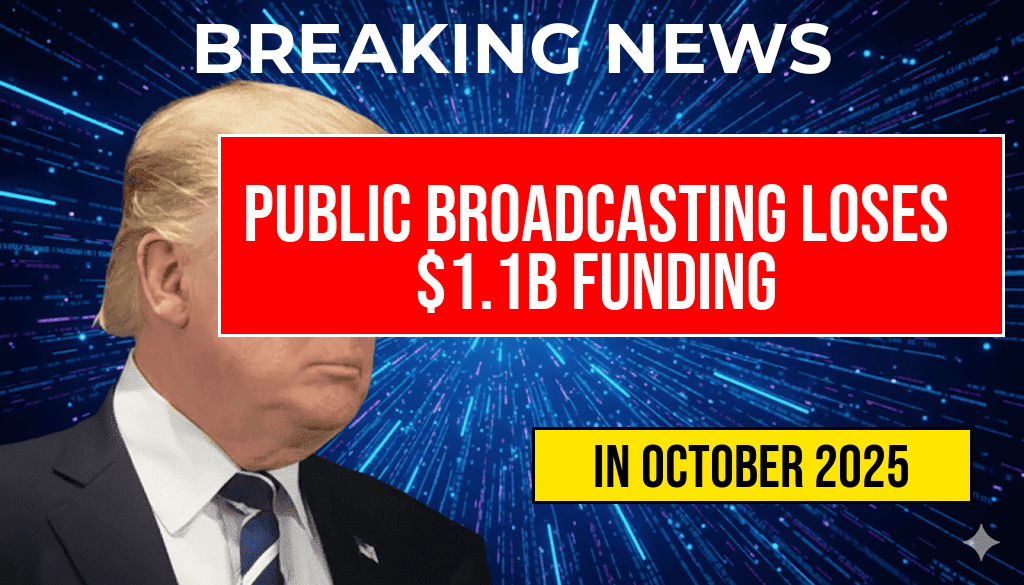Federal funding for public broadcasting has been significantly reduced under the recent Rescissions Act, resulting in a $1.1 billion cut from the allocated budget. This move impacts numerous PBS stations, NPR affiliates, and other public media outlets nationwide, raising concerns about the future of non-commercial educational programming and community-based media services. The reduction, part of a broader effort to trim federal expenditures, has sparked debates among policymakers, media professionals, and public advocates about the implications for access to independent journalism, educational content, and cultural programming. The rescission, which took effect immediately upon signing, underscores ongoing tensions over federal support for public media amid competing budget priorities and political considerations. As public broadcasters prepare to navigate this funding gap, stakeholders are calling for alternative strategies to sustain essential services and maintain public trust in independent media sources.
Background on Federal Funding for Public Broadcasting
Since its inception, federal support has played a crucial role in sustaining public broadcasting services across the United States. The Corporation for Public Broadcasting (CPB), established in 1967, administers federal funds that support PBS, NPR, and affiliated stations, enabling the provision of educational, cultural, and news programming that is accessible nationwide. Historically, federal allocations have fluctuated with changing administrations and budget priorities, but the recent rescission marks one of the most substantial cuts in recent memory.
Details of the Funding Reduction
| Program/Area | Previous Funding (USD) | Reduced Funding (USD) | Impact Description |
|---|---|---|---|
| Federal support via CPB | $445 million (2023) | $0 | Complete elimination of direct federal funding for CPB |
| State and local grants | $200 million | Reduced by $150 million | Significant cuts to station-specific funding for local programming |
| Educational and community outreach programs | $100 million | $50 million | Partial reduction impacting outreach initiatives |
Reactions from Public Media Stakeholders
Public Broadcasters and Advocacy Groups
Leaders within public broadcasting have expressed concern over the immediate effects of the rescission. Patricia Harrison, President and CEO of the Corporation for Public Broadcasting, issued a statement emphasizing the importance of federal support: “Public media plays a vital role in delivering unbiased news, educational content, and cultural programming. The abrupt funding reduction threatens our ability to serve underserved communities and maintain programming quality.”
Many stations are contemplating layoffs, reduced programming hours, or the suspension of community outreach initiatives. The Wikipedia page on public broadcasting in the U.S. details the extensive network of stations that could be affected.
Political Responses and Legislative Actions
Lawmakers from both parties have responded differently. Some Republicans cited the need for fiscal responsibility and questioned the efficiency of public broadcasting funding, while Democrats argued for the importance of maintaining access to independent, non-commercial media. Several members of Congress have introduced proposals to restore or supplement funding through alternative channels, emphasizing the role of public media in fostering civic engagement and education.
Potential Long-Term Effects
Impact on Programming and Community Services
With the loss of federal support, many public broadcasters may face scaling back on educational initiatives, local journalism, and outreach programs that serve rural and underserved populations. The reduction could also lead to diminished content diversity, affecting programming that reflects local cultures and issues.
Financial Strategies Moving Forward
- Increasing private donations and grants from foundations
- Expanding digital and streaming services to reach broader audiences
- Forging partnerships with educational institutions and community organizations
Public broadcasters are exploring these avenues to mitigate the impact of the funding cut, but experts warn that the transition may not fully compensate for the loss of federal dollars.
Broader Context and Future Outlook
The $1.1 billion rescission reflects a broader trend of scrutinizing and reducing federal spending on programs perceived as non-essential by some policymakers. As debates continue over the role of public media in American society, the coming months will reveal how federal, state, and private sectors collaborate to sustain these vital services. Stakeholders remain hopeful that increased community engagement and innovative funding models can help preserve the integrity and accessibility of public broadcasting amid fiscal uncertainties.
Frequently Asked Questions
What is the main impact of the Rescissions Act on public broadcasting funding?
The Rescissions Act results in a $1.1 billion funding reduction for public broadcasting, significantly affecting its financial resources and operations.
Which organizations are affected by the funding reduction?
The public broadcasting sector, including local public TV and radio stations and national organizations like PBS and NPR, are impacted by the funding cuts.
What are the potential consequences of the funding reduction for public broadcasting services?
The reduction in funding may lead to program cuts, staff layoffs, and reduced service offerings, potentially impacting the quality and availability of public broadcasting content.
Why was the funding rescinded under this act?
The Rescissions Act was enacted as part of broader efforts to reduce federal spending, resulting in the clawback of allocated funds from various programs, including public broadcasting.
How might public broadcasting organizations respond to this funding reduction?
Organizations may seek alternative funding sources, implement cost-saving measures, or advocate for reinstatement of funds to sustain their services amidst the cuts.






